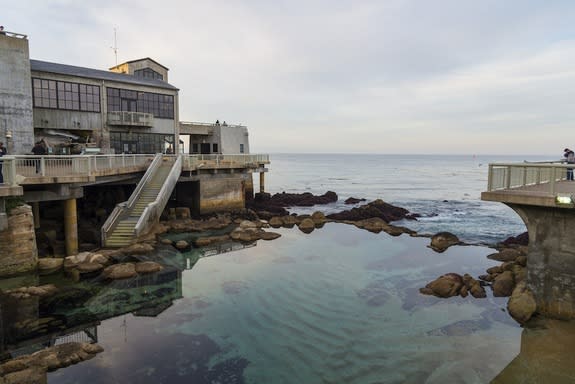Photos Show Beauty of California's King Tides
The tide hit a high point — a very high point — today along the California coast, as seen in gorgeous photographs taken at the Monterey Bay Aquarium in Monterey.
The aquarium's stairs descend into the sea in images posted on Twitter. The extreme tide is known as a "king tide," a seasonal phenomenon caused by the interaction of the gravity of the sun and moon with weather.
Tides are caused by the gravitational interaction of the sun, moon and Earth. The Earth orbits the sun in an elliptical path, just as the moon's journey around the Earth is not perfectly circular. When the orbits of the three bodies bring them in closer proximity, the gravitational forces are stronger, and the tides higher. When Earth, moon and sun are farther apart, the tides are weaker.
King tides are the highest tides of the year. They occur around the summer and winter solstices, when the alignment of the Earth maximizes the gravitational pull from the sun, according to the California King Tides Initiative, a collaboration of government agencies and non-profit organizations. Winter storms along the West Coast can exacerbate these high tides.
Yesterday (Jan. 2), Earth reached perihelion, its closest point to the sun. This perihelion coincided with the moon's perigee, the point at which it comes closest to the Earth.
The predicted high tide for Monterey, Calif., on Jan. 2 was 6.61 feet (2 meters), according to the National Oceanic and Atmospheric Administration (NOAA). For comparison, the highest tide on Oct. 2, three months ago, was about 5 feet (1.5 meters).
King tides are normal, but officials warn that coastal areas can flood and waves can reach higher than beach-goers are used to during these periods. The California King Tides Initiative was formed to raise awareness of these tides, and to point out that as global warming leads to higher sea levels, today's king tides could be tomorrow's norm.
Follow Stephanie Pappas on Twitter and Google+. Follow OurAmazingPlanet @OAPlanet, Facebook and Google+. Original article at LiveScience's OurAmazingPlanet.
Copyright 2014 LiveScience, a TechMediaNetwork company. All rights reserved. This material may not be published, broadcast, rewritten or redistributed.



